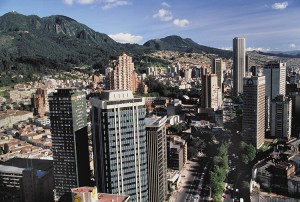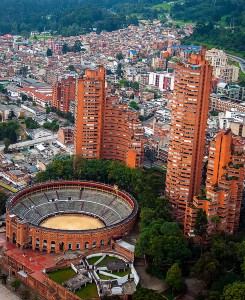Bogotá 480
August 7, 2018
Yesterday, on August 6, Bogotá, Colombia’s capital and largest city, celebrated the 480th anniversary of its founding in 1538. One of the oldest cities founded by Europeans in South America, Bogotá is also one of the biggest. Some 8 million people call the city home. Bogotá hosts a birthday carnival every year on August 5 and 6, a raucous celebration of the city’s—and the nation’s—cultural and musical diversity.

Bogotá sits high in the Andes Mountains of central Colombia. The city was founded 480 years ago on Aug. 6, 1538. Credit: © Stone from Getty Images
Bogotá’s birthday carnival centers on the city’s Simón Bolívar Park, and parades teeming with dancers and musicians in vibrant costumes spiral into the nearby streets. Aromas of ajiaco—the city’s traditional chicken and potato soup—compete with stuffed arepas and empanadas for revelers’ culinary attentions. The Bogotá Philharmonic Orchestra plays a more subdued free concert in the city’s main square, the Plaza de Bolívar, and individual parties take place in every barrio (neighborhood). At sunset, fireworks erupt from atop the 643-foot- (196-meter-) high Torre Colpatria, Colombia’s tallest completed building. The south tower of the nearby BD Bacatá complex (scheduled to open later this year) looks down on the Colpatria by about 210 feet (64 meters). Bacatá is the Muisca Indian word for the region that gave Bogotá its name.
Bogotá was founded as Santa Fe de Bogotá in 1538 by Gonzalo Jiménez de Quesada, a Spanish military leader who conquered the area’s Muisca and Chibcha Indians. In the early 1700′s, the city became the capital of the Viceroyalty of New Granada. The viceroyalty consisted of what are now Colombia, Venezuela, Ecuador, and Panama. In 1830, Bogotá became the capital of independent New Granada, later renamed Colombia.

The Santamaría bullring, shown here, is one of Bogotá’s key points of interest. The Park Towers, designed by Colombian architect Rogelio Salmona, rise beside the bullring. Credit: © Jess Kraft, Shutterstock
Bogotá lies on a plateau about 8,660 feet (2,640 meters) above sea level, in the Andes Mountains in central Colombia. The steep mountains that surround much of Bogotá give the city a dramatic physical setting. One peak is crowned with a figure of Jesus Christ, another with a cross, and a third with a shining white convent. Cable cars travel between the city and the top of Monserrate, a mountain that is a popular observation point. A mansion at the foot of the mountain once belonged to the South American general Simón Bolívar. It is now a museum that displays items relating to Bolívar and South America’s struggle for independence.
At the center of Bogotá is the Plaza de Bolívar. It is surrounded by historic buildings, including the Cathedral; the Archbishop’s Palace; Liévano Palace, which houses the mayor’s office; and the Capitol. Nearby, mansions from the Spanish colonial era, which lasted from the 1500′s to the early 1800′s, line the narrow streets. The Gold Museum has a collection of about 35,000 gold works of art crafted by Indians before the Spaniards arrived.


